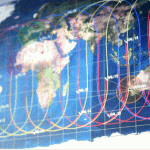Keysight Technologies recently became the first to receive Global Certification Forum (GCF) validation of a 5G location based services (LBS) Assisted Galileo (A-Galileo) test case by combining 5G new radio (NR) and GNSS technology—an achievement that will accelerate the implementation of LBS in smartphones.
Together, 5G NR and GNSS make assisted GNSS (A-GNSS), enabling mobile phone vendors to verify that designs comply to the latest 3GPP specifications that support accurate location positioning for sectors like health care, road and aerial transportation, emergency and rescue services, public safety, and homeland security. Precise positioning services also make it possible to deliver personalized services that support entertainment, hospitality and retail applications.
“A-GNSS allows a GNSS receiver in the 5G smartphone to obtain info from network resources to assist in satellite location,” Keysight General Manager Muthu Kumaran said. “It is useful, especially when the receiver is in a location where it is difficult for a satellite signal to penetrate. The challenge is satellites have a very low signal level because they are far in space, so GNSS receiver performance is crucial. Industry certification becomes important to guarantee its performance, according to the standard.”
Achieving validation
The approval process required Keysight to implement the 3GPP defined test in its E7515B UXM 5G Wireless Test Platform, a compact signaling test platform with multiformat stack support, rich processing power, and abundant RF resources for emulating various mobility scenarios in a 5G network as well as a recommended GNSS emulator to deliver the LBS test case. The test case is validated by capturing pass logs from two different devices and submitting them to an independent validation organization to check specification compliance, Kumaran said. The GCF conformance agreement group (CAG) meeting #72 confirmed the validation of the test case in October.
The test case was supported by Keysight’s S8705A RF/RRM DVT and Conformance Toolset. The toolset provides access to a wide range of radio frequency, radio resource management (RRM), and development validation test (DVT) test cases used to verify 5G NR designs in both non-standalone (NSA) and standalone (SA) deployment modes.
“The S8705A toolset supports the widest validated coverage for 5G NR test cases including TRx, Demod, RRM, Data Throughput, and A-GNSS, enabling a user to do pre-testing and conformance testing of their products before market roll out,” Kumaran said. “The toolset also allows flexible parametrization of the test to benchmark the device and test it beyond the limits established by conformance regimes.”
Why LBS
A location-based service is any technology that depends on real-time location tracking to function, Kumaran said.
“The technology constantly identifies the user’s physical and geographical location, which is then used to perform services and functions,” Kumaran said. “The main technology is GNSS (GPS, Galileo, Glonas, Beidou), but cellular technology, using base station triangulation, can also be combined with GNSS to increase accuracy of location.”
LBS test cases like this one allow users to verify sensitivity, accuracy and dynamic range in mobile phones that use satellite constellations to identify precise geographic location.
A variety of industries can benefit from LBS, including travel. Rideshare apps us LBS to function, while roadside assistance companies often provide an app that makes it possible to track someone’s exact location after a car accident, for example, Kumaran said.
Public safety is another area where LBS plays a critical role, Kumaran said, by identifying the physical locations of emergency callers.
“When callers to Public Safety Answering Points (PSAPs) can’t accurately provide their location, measures are needed to dispatch first responders to the right place,” Kumaran said. “Similarly, in a mass emergency event, the ability to send intelligent messages only to those users within a well-defined geographic area can make official response measures more effective. Both these scenarios depend on the accuracy, speed, and reliability of automated LBS to help public-safety personnel find and assist those in need.”
What’s next
Keysight plans to increase test case coverage for LBS either for Assisted Galileo, Assisted GPS or Assisted Beidou, Kumaran said, and will work to obtain the first GCF validation for LBS test cases for the Glonass global navigation satellite system as soon as devices are available.
Once that goal is met, the company will focus on validation of positioning enhancements in Rel-16, enabling accurate positioning with GNSS assisted by cellular networks, not only outdoors with satellite visibility, but also indoors.
“For that, devices will need to support a new downlink-based positioning method to meet the positioning accuracy demanded in these new scenarios,” Kumaran said. “This new method is based on a new positioning reference signal (PRS) that enables a more precise time of arrival (ToA) estimation. The UE will report PRSs received from multiple base stations and this information will allow the accurate determination of its position.”
Keysight will continue providing the support of positioning enhancements tests to be included in Rel-17 with a focus on Industrial Internet of Things scenarios, Kumaran said, which will require higher accuracy and lower latency.
“New applications demand new scenarios where it is required to know the device position faster and with more and more accuracy,” Kumaran said. “This is achieved combining global navigation satellite system (GNSS) and cellular technologies.”






